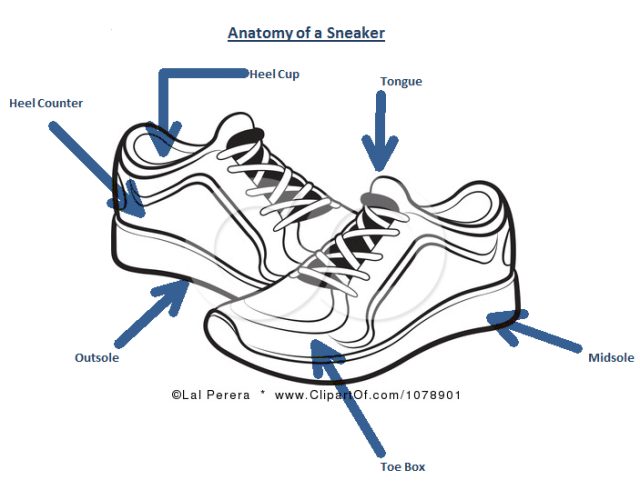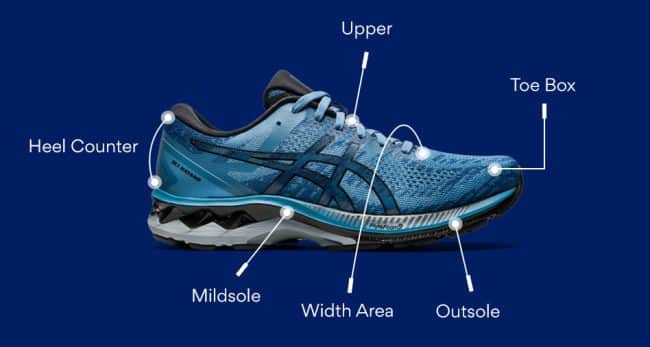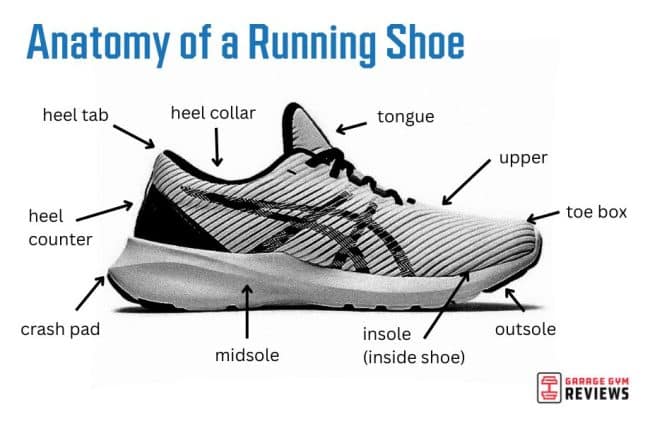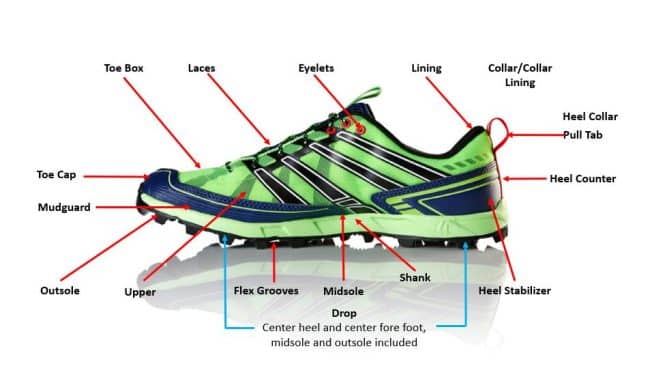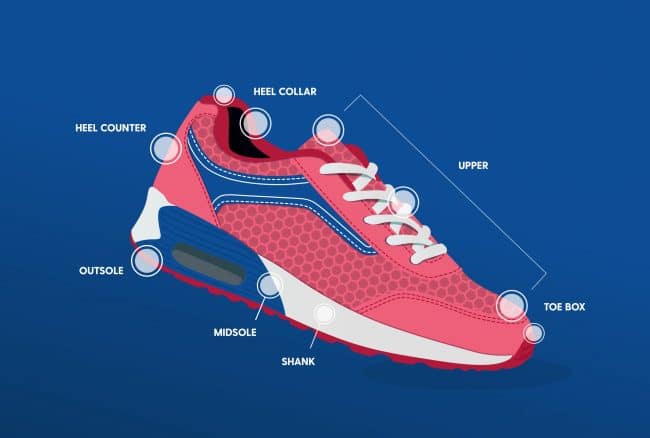Every time we slip on a pair of running shoes, we’re probably not giving much thought to the different components that make up the shoe. From the cushioning to the laces, each part has a specific purpose to enhance our running experience. One such component that often goes unnoticed is the heel counter. But what exactly is the purpose of the heel counter on running shoes? In this article, we will explore this often overlooked feature and uncover its significance in providing stability and support during our runs. So, let’s lace up and dive into the world of the heel counter!
This image is property of runkeeper.com.
Review contents
Definition of heel counter
The heel counter is a component of running shoes that provides support and stability to the back of the foot. It is a stiff material that is strategically placed around the heel area to help prevent excessive inward rolling (pronation) and promote proper alignment of the foot and ankle during the running or walking motion. The heel counter works in conjunction with other features of the shoe to enhance comfort, reduce foot fatigue, and prevent injuries.
Explanation of heel counter
The heel counter is an essential part of a running shoe’s design that serves multiple purposes. It helps to secure the foot inside the shoe, improves stability, limits excessive movement, and enhances overall performance. The primary goal of the heel counter is to provide support and prevent overpronation, a common issue where the foot excessively rolls inward upon impact with the ground. This helps to maintain proper alignment and reduce stress on the foot, ankle, and lower leg.
Materials used for heel counter
Heel counters can be made from various materials, each with its own unique characteristics and benefits. Common materials used for heel counters include:
-
Thermoplastic polyurethane (TPU): TPU is a durable and lightweight material that offers excellent stability and support. It is often used in rigid or semi-rigid heel counters.
-
Carbon fiber: Carbon fiber is known for its strength and stiffness while remaining lightweight. It provides excellent support and is commonly used in high-performance running shoes.
-
EVA (ethylene-vinyl acetate): EVA is a cushioning material that can be used to create a more flexible heel counter. It offers a softer feel and allows for a greater range of motion.
-
TPU/EVA blend: Some shoe manufacturers combine TPU and EVA to create a heel counter that provides a balance of stability and flexibility.
-
Nylon: Nylon is a versatile material that can be used in both rigid and flexible heel counters. It offers durability and helps maintain the shape of the counter over time.
The choice of material for the heel counter depends on the desired level of support, flexibility, and overall shoe design.
Importance of the heel counter
The heel counter plays a crucial role in providing support, stability, and preventing overpronation in running shoes. Here are some key reasons why the heel counter is important:
Support and stability
The heel counter provides support to the foot, helping to keep it securely in place and preventing excessive movement inside the shoe. This support contributes to the overall stability of the foot and ankle, reducing the risk of injuries caused by instability.
Prevention of overpronation
Overpronation can lead to various foot and lower leg issues, including shin splints, plantar fasciitis, and stress fractures. The heel counter helps to limit excessive inward rolling of the foot, preventing overpronation and promoting a more natural and efficient gait cycle.
Reduction of foot fatigue
By providing support and stability, the heel counter helps to reduce the strain and fatigue on the foot and lower leg muscles. This can enhance comfort during long-distance runs and prevent premature muscle fatigue, allowing for a more enjoyable running experience.
Alignment of the foot and ankle
Proper alignment of the foot and ankle is crucial for maintaining proper biomechanics and reducing the risk of injuries. The heel counter helps to align the foot and ankle, promoting optimal positioning and reducing the stress on the joints and soft tissues.
Injury prevention
The heel counter plays a significant role in injury prevention. It helps to control excessive motion, limit stress on vulnerable areas, and provide support during the impact phase of running or walking. By reducing the risk of overpronation and promoting proper alignment, the heel counter can help prevent common running injuries.
This image is property of www.garagegymreviews.com.
How does the heel counter work?
The effectiveness of the heel counter in providing support, stability, and preventing overpronation depends on various factors, including its structural design, placement in the shoe, and materials used. Here is how the heel counter works:
Structural design and placement
The shape and design of the heel counter are carefully engineered to provide optimal support and stability. It is typically structured to wrap around the heel and extend up the sides of the shoe to create a secure and supportive fit. The heel counter is strategically positioned to align with the natural contours of the foot and ankle, ensuring maximum effectiveness in controlling motion and enhancing stability.
Impact absorption
During the running or walking motion, the heel counter absorbs and disperses the forces generated upon impact with the ground. This helps to minimize the stress on the foot, ankle, and lower leg, reducing the risk of injuries.
Counteracting excessive inward rolling
One of the primary functions of the heel counter is to counteract excessive inward rolling or overpronation. The firmness and stiffness of the heel counter provide resistance against the natural tendency of the foot to excessively roll inward. This helps to maintain proper alignment and prevent strain on the foot’s supportive structures.
Improving gait cycle
The heel counter can influence the gait cycle by promoting a more efficient and natural stride. It helps to guide the foot through the different phases of the gait cycle, including heel strike, midstance, and toe-off. This improves overall propulsion and contributes to better running or walking performance.
Promoting propulsion
By providing stability and support to the foot, the heel counter enables a more powerful push-off during the toe-off phase of the gait cycle. This promotes efficient propulsion and helps runners achieve faster speeds and better performance.
Types of heel counters
Running shoes can feature different types of heel counters, each offering varying degrees of support and flexibility. Here are the main types of heel counters:
Rigid heel counters
Rigid heel counters are made from stiff materials such as TPU or carbon fiber. They provide maximum support and stability to the foot and are ideal for individuals with severe overpronation or those seeking maximum control and motion restriction.
Semi-rigid heel counters
Semi-rigid heel counters offer a balance between support and flexibility. They are often constructed using a combination of materials like TPU and EVA. Semi-rigid heel counters provide a moderate level of stability and are suitable for individuals with mild to moderate overpronation.
Flexible heel counters
Flexible heel counters are made from softer materials like EVA. They offer a greater range of motion and flexibility, allowing for a more natural foot movement. Flexible heel counters are generally suited for individuals with neutral foot mechanics or those who prefer a more flexible and cushioned feel in their shoes.
Customizable heel counters
Some running shoe brands offer customizable heel counters that can be adjusted to fit the individual’s specific foot shape and needs. These heel counters often feature interchangeable inserts or additional padding to provide a personalized fit and enhanced comfort.
The choice of heel counter type depends on factors such as foot mechanics, pronation, running style, and personal preference.
This image is property of spotterup.com.
Considerations when choosing a heel counter
When selecting running shoes with a suitable heel counter, several factors should be considered to ensure the best fit and support. Here are some key considerations:
Foot type and pronation
Understanding your foot type and pronation pattern is crucial when choosing a heel counter. Pronation refers to the natural rolling of the foot inward upon impact. If you have excessive pronation (overpronation), you may benefit from a shoe with a more rigid heel counter to provide optimal stability and control.
Running style and gait analysis
Analyzing your running style and gait can help determine the type of heel counter that best suits your needs. A gait analysis can be performed by a professional shoe fitter or a podiatrist to assess your foot mechanics, pronation, and overall biomechanics. This evaluation can guide you in selecting a shoe with the appropriate heel counter for your specific gait.
Injury history
If you have a history of foot or lower leg injuries, it is essential to consider the heel counter’s support and stability features. A shoe with a more rigid or semi-rigid heel counter may be beneficial in providing additional protection and preventing further injuries.
Personal preference
Individual preferences, such as the desired level of cushioning, flexibility, and comfort, should also be taken into account when choosing a heel counter. Some runners may prefer a more flexible counter for a natural feel, while others may prioritize maximum support and stability.
Limitations and disadvantages of heel counters
While heel counters offer numerous benefits, it is important to be aware of their limitations and potential disadvantages. Some of these include:
Restrictiveness
The rigid or semi-rigid nature of certain heel counters may feel restrictive or confining to some individuals, especially those who prefer a more flexible and unrestricted foot movement.
Potential discomfort
In rare cases, the rigidity of the heel counter or the materials used in its construction may cause discomfort or pressure points on the back of the foot. It is crucial to ensure a proper fit and consider alternatives if discomfort persists.
Lack of adaptability
Heel counters are integrated into the design of the shoe and cannot be adjusted or modified once manufactured. Therefore, they may not provide a perfect fit for everyone, particularly individuals with unique foot shapes or specific support requirements.
May not address specific foot issues
While heel counters offer general support and stability, they may not always address specific foot issues or conditions. Individuals with more severe foot deformities or specific medical conditions may require additional support from custom orthotics or specialized footwear.
This image is property of www.myfootdr.com.au.
Alternative technologies to heel counters
While heel counters are widely used and effective, the following alternative technologies can also provide support and stability in running shoes:
Footwear with no heel counters
Some minimalist or barefoot-style running shoes do not feature a built-in heel counter. Instead, they rely on other design elements, such as a wider toe box, cushioning, or midsole architecture, to provide stability and support. These shoes promote a more natural foot movement and encourage the foot’s intrinsic stabilization mechanisms.
Custom orthotics and insoles
Individuals with specific foot conditions or biomechanical abnormalities may benefit from custom orthotics or insoles. These are specially designed inserts that provide personalized support and can be used in conjunction with running shoes to enhance stability and reduce the risk of injuries.
Other support features
Running shoes often include additional features to complement the heel counter and provide added support. These features may include arch support, midfoot shanks, cushioning technologies, or upper materials that secure the foot in place.
Choosing the right running shoe with the appropriate heel counter
Selecting the right running shoe with an appropriate heel counter can significantly impact comfort, performance, and injury prevention. Here are some tips for finding the perfect fit:
Getting a proper fit
Ensure that the shoe fits properly and provides ample space for your toes to move comfortably. The heel counter should wrap snugly around the heel without causing any discomfort.
Seeking professional advice
Visit a specialty running store or consult with a shoe fitting expert to receive personalized guidance. These professionals can analyze your gait, foot mechanics, and recommend suitable shoe models with the right type of heel counter for your needs.
Trying different models
Experiment with different shoe models and brands to find the one that feels the most comfortable and provides the desired level of support. Each brand may have its own unique heel counter design and materials, so it’s worth exploring various options.
Considering future needs
If you plan to increase your running distance or intensity in the future, it is advisable to select a shoe with a more supportive heel counter. This will help accommodate your future needs and prevent potential overuse injuries.
This image is property of walkwellstaywell.files.wordpress.com.
Care and maintenance of heel counters
Proper care and maintenance of heel counters can extend their lifespan and ensure continued support and effectiveness. Here are some tips for caring for your running shoes’ heel counters:
Cleaning techniques
Follow the manufacturer’s guidelines for cleaning your running shoes. Use mild soap, water, and a soft brush to gently clean the heel counter. Avoid harsh cleaning agents or abrasive materials that could damage the counter’s structure.
Avoiding excessive wear and tear
Minimize excessive strain on the heel counter by avoiding activities or surfaces that may accelerate wear and tear. Taking care of your running shoes in general, such as avoiding extreme temperatures or exposure to water, can help maintain the integrity of the heel counter.
Replacement considerations
Over time, the heel counter may lose its effectiveness or become worn out. It is recommended to replace running shoes when the heel counter shows visible signs of deterioration, such as cracks, deformities, or loss of support. Regularly assessing the condition of the heel counter and the overall shoe can help prevent potential injuries and maintain optimal performance.
Conclusion
The heel counter is a critical component of running shoes that provides support, stability, and injury prevention. It helps to control overpronation, reduce foot fatigue, and promote proper alignment of the foot and ankle. By understanding the different types of heel counters, considering individual needs, and seeking professional advice, runners can select the right shoe that offers the ideal level of support and comfort. Proper care and maintenance of the heel counter can further enhance its lifespan and ensure consistent performance. So, next time you lace up your running shoes, remember the role that the heel counter plays in keeping your feet happy, stable, and injury-free.

